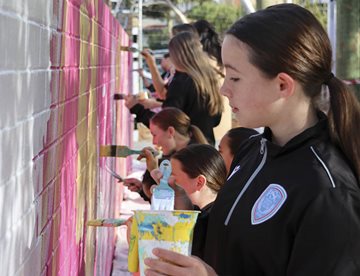WALGA advocates on behalf of the Local Government sector to secure ongoing funding through budget allocations at a State and Federal level.
This involves providing Government with a submission of initiatives that will deliver significant benefits to communities across Western Australia.
When Federal and State Budgets are handed down, WALGA provides instant analysis, focusing on what the announcements and funding initiatives mean for Local Governments in Western Australia.

State Budget
2024-25 Submission
WALGA advocates on behalf of the Local Government sector to prioritise initiatives and projects, and secure ongoing funding through budget allocations.
With an on-the-ground presence across the state, WALGA is in a position to articulate economic, social and environmental challenges at a community level and prioritise areas for funding.
In this year’s submission to State Government, WALGA focused in delivering significant benefits to communities through:
- Safer roads
- Community infrastructure for a changing population
- Climate Action
- Accelerate the transition to a circular economy
- Disaster resilient communities
- Address gaps in services to communities
- Better governance and oversight
Federal Budget
On 9 May 2023, Treasurer Jim Chalmers handed down the 2023-24 Federal Budget. Given the high inflation environment and rapid increase in interest rates, the Budget sought to provide cost of living relief to households and deliver on the Government’s spending priorities, without adding further to price pressures.
For Local Governments, the Budget retained its commitment to a number of important funding programs. However, there was little by way of new spending announcements.
WALGA's analysis and commentary
Given the high inflation environment and rapid increase in interest rates, the Budget sought to provide cost of living relief to households and deliver on the Government’s spending priorities, without adding further to price pressures.
Fiscal restraint was a focus of the budget, which is expected to be in surplus for the first time in 15 years. A $4.2 billion surplus is predicted in 2022-23, as tax revenues came in higher than expected due to the strong labour market, high commodity prices and elevated company tax. However, the Budget is expected to slip back into deficit across the forward estimates as economic conditions deteriorate in line with global economic challenges.
Cost of living was a centrepiece of the budget, with $14.6 billion in relief provided for households over the next four years. A range of measures have been announced to take pressure off costs, including energy bill relief for households and small businesses, reduced costs for healthcare and medicines, childcare support and rent assistance.
The Budget also focussed on healthcare and aged care. The headline announcement in this area included $5.7 billion over five years to strengthen Medicare by tripling bulk billing incentives (for children under 16, pensioners and other concession card holders). More than 250,000 aged care workers will receive a 15% increase in salaries and there is an expansion in the number of urgent care clinics.
Other key areas of spending were directed towards addressing disadvantage and strengthening the economy through development of the renewable energy industry, and addressing skills shortages.
For Local Governments, the Budget retained its commitment to a number of important funding programs. However, there was little by way of new spending announcements.
It is disappointing the Government did not deliver on its commitment to a fair and reasonable increase in Financial Assistance Grants. This year, $3.1 billion has been provided for Financial Assistance Grants funding, with WA to receive $376.9 million. Financial Assistance Grants now represent 0.5% of total Commonwealth Tax revenue, down from 0.52% in 2022-23.
The Government has indicated that it will continue to work with states in relation to the financial sustainability of the Local Government sector, including advancing 75 per cent of funding “earlier than would usually occur”.
To read more about what the Federal Budget means for Local Governments visit the Australian Local Government Association website.
WALGA will work through the detail of the Budget in coming weeks and keep the sector informed on any major issues affecting Local Government.
If you have any further questions on the Federal Budget, contact WALGA’s Economics team.
Other key areas of funding in the Budget for Local Governments are as follows.
- $2.4 billion for the Roads to Recovery Program between 2022-23 and 2026-27. WA will receive $360.6 million of this funding.
- $600.7 million for Black Spot Projects between 2022-23 and 2026-27, including $67.1 million for WA.
- $485.4 million for the Bridges Renewal Program 2022-23 and 2026-27, with $52.5 million allocated to WA.
- Additional $200 million over two years from 2023-24 for the Major Projects Business Case Fund to support the planning of land transport infrastructure projects.
- $1.8 billion has been provided for the Local Roads and Community Infrastructure Program between 2022-23 and 2025-26, with WA to receive $246.9 million. The additional $250 million investment in 2024-25 and 2025-26 is available to Councils classified as rural, regional or outer-urban to spend on road projects. Funding has not been extended beyond 2025-2026.
- Funding for several new initiatives including:
- $211.7 million over three years from 2023-24 to establish the Thriving Suburbs Program to provide grants for community infrastructure in urban and suburban communities through a competitive grants program
- $159.7 million over four years from 2023-24 to establish the Urban Precincts and Partnerships Program, to support investment in place based priorities of local urban communities through a collaborative partnerships approach with State and Local governments and communities
- $10.1 million over two years from 2023–24 to scope the capability needs to modernise Australia’s emergency service communications.
- $10 million over two years for a National Waste Education Campaign.
- $83.2 million over four years for a new Net Zero Authority, which will work with State and Local Governments, workers, regional communities and First Nations people to facilitate economic development and diversification in the transition to a clean energy economy.

